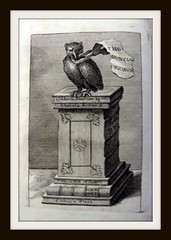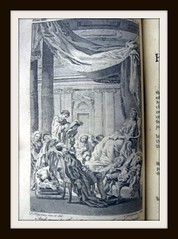
Special Collections will be featuring an exhibit on Eighteenth-Century Book Illustration, which will be housed in our Reading Room until the middle of the semester. There will be a number of blog entries dedicated to the contents of this exhibit. The first display case features illustrations from four editions of Alexander Pope’s satirical poem, The Dunciad.
Alexander Pope (1688-1744) was a British poet, recognized for his poetry and translations. His most famous work is the mock-heroic epic, The Rape of the Lock, which tells the story of a feud between two families initiated by Lord Petre’s snipping a lock of Belinda’s hair without permission. Pope also completed translations of Homer’s Iliad and Odyssey. The greatness of Pope’s literary achievements is remarkable considering the disadvantages that Pope had to surmount. He was Roman Catholic during a period of intense anti-Catholicism in Britain and thus was prohibited from attending university or living within ten miles of London. Further, Pope was plagued by chronic ill-health. He suffered from a particular form of tuberculosis that stunted his growth and caused a hunched back.
Special Collections has chosen to exhibit illustrations from The Dunciad because of the differences in illustration between early and later editions. Throughout The Dunciad, Pope satirized writers whom he felt produced sub-par literature or wrote in an excessively pedantic style that Pope found ludicrous. Although Pope did not explicitly name these authors within the text of the poem, he certainly had specific authors in mind and provided clues; a contemporary audience would not have had difficulty recognizing the individuals he was satirizing. Early illustrations for the poem play up the specificity of Pope’s attacks. In illustrations featured in the 1727 and 1729 editions, an owl perches atop books that are clearly labeled with an author’s name, a well-known title, or both. However, mid and late eighteenth-century editions featured illustrations that mocked dullness and pedantry without embedding as many keys to definite writers or texts. For example, one of these illustrations shows the goddess of Dullness asleep on her throne, lulled by the reading of a monotonous book. Notably, the illustrator leaves the book unidentified. Comparing illustrations from early and later editions of Pope’s Dunciad reveals eighteenth-century illustrators and publishers adapting illustrations to suit different audiences.

